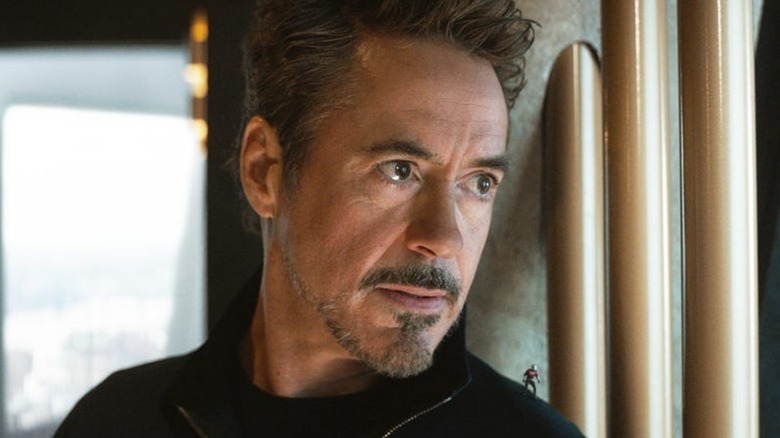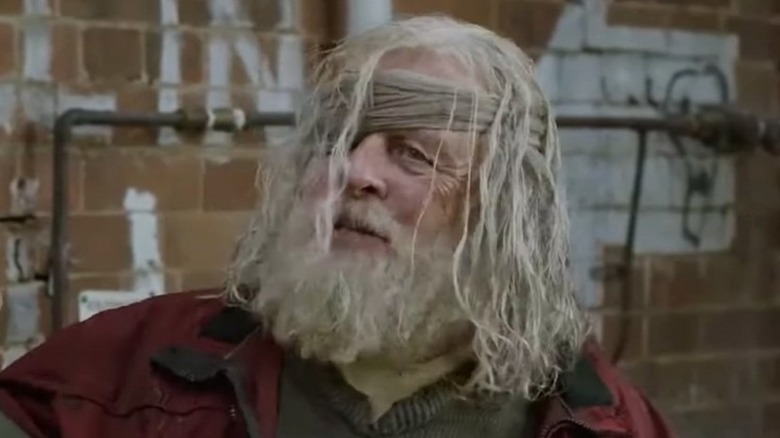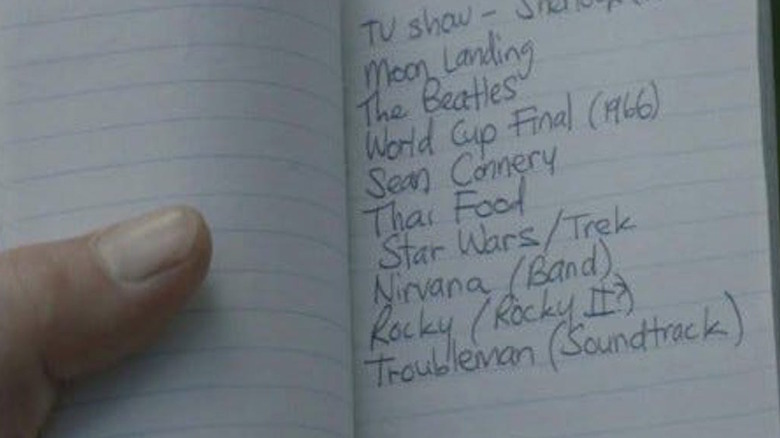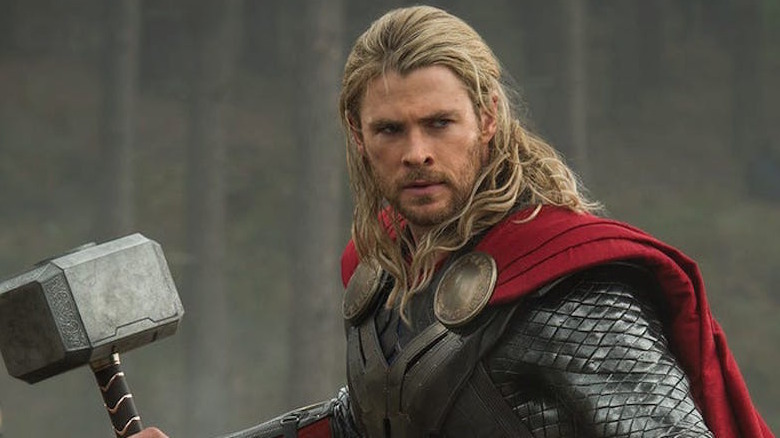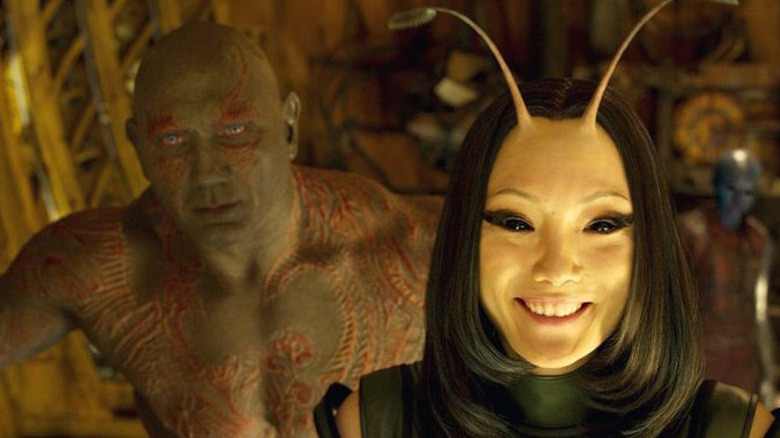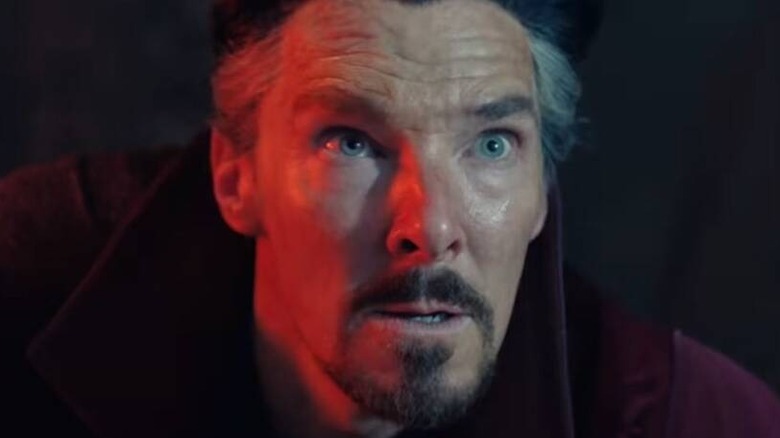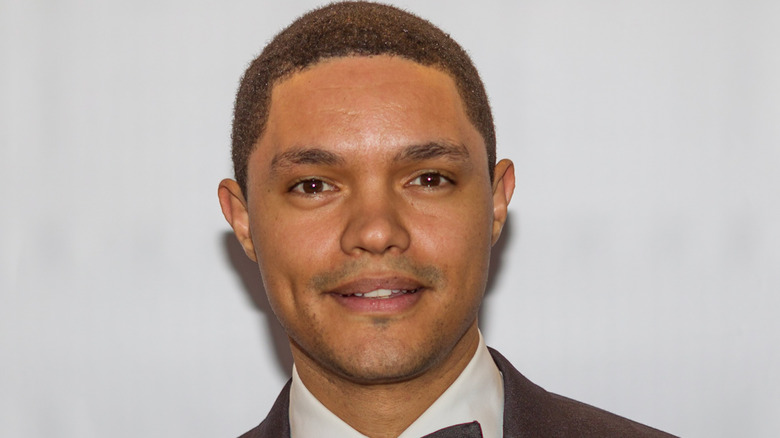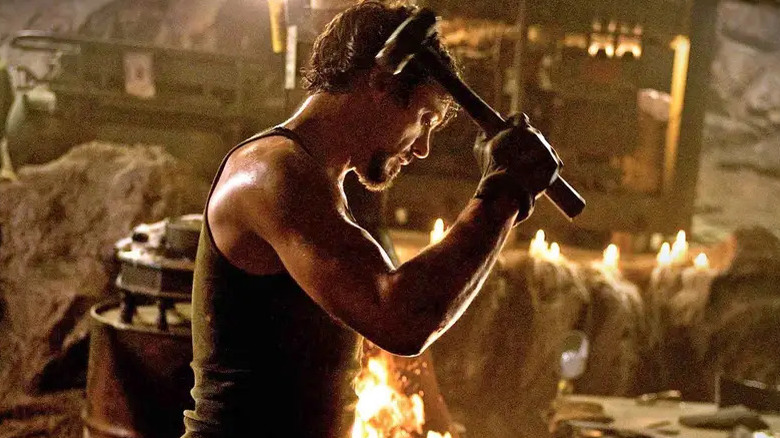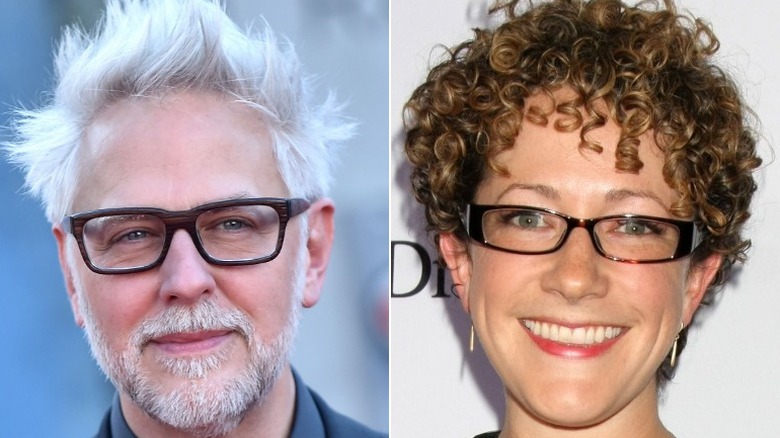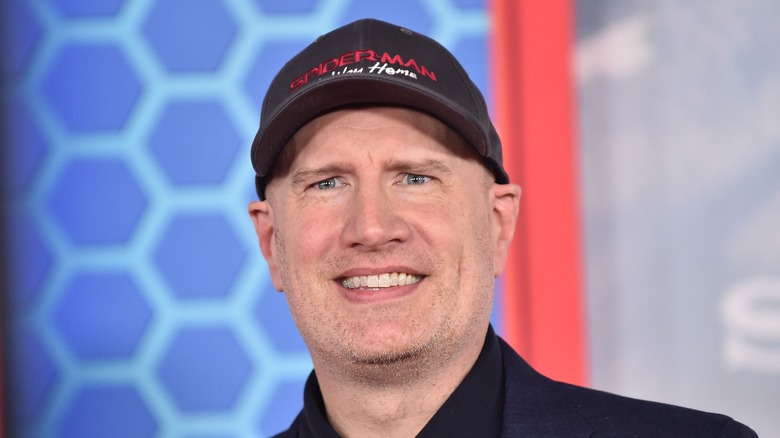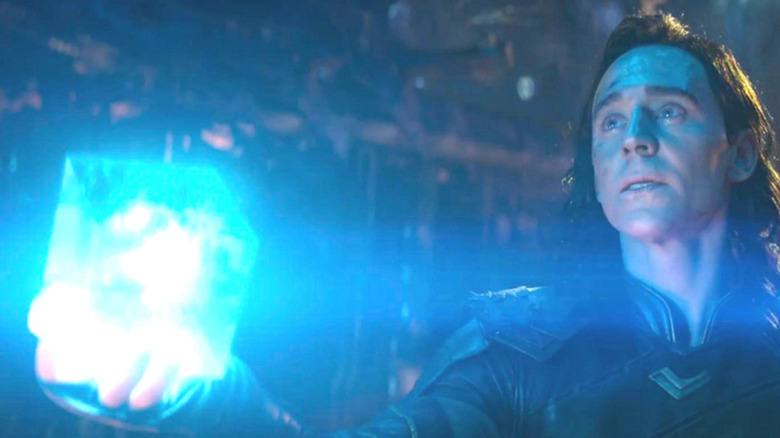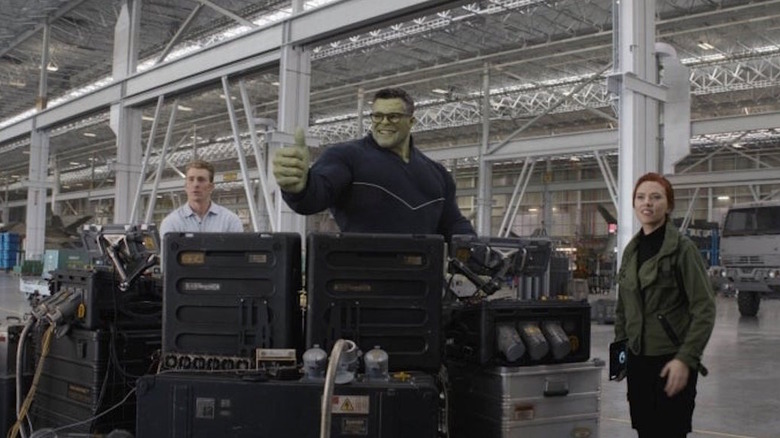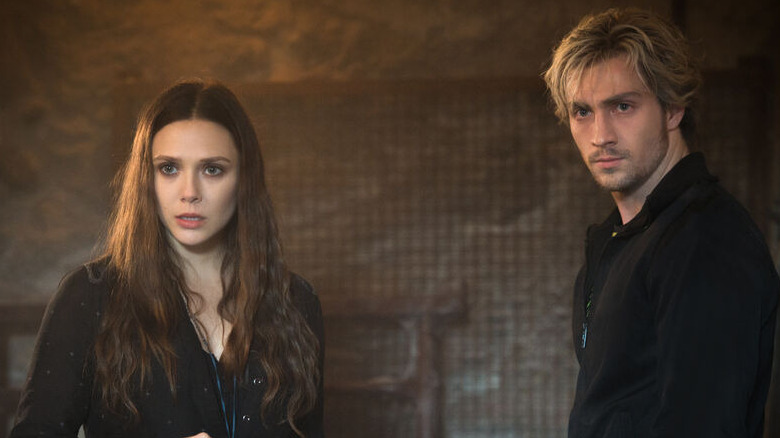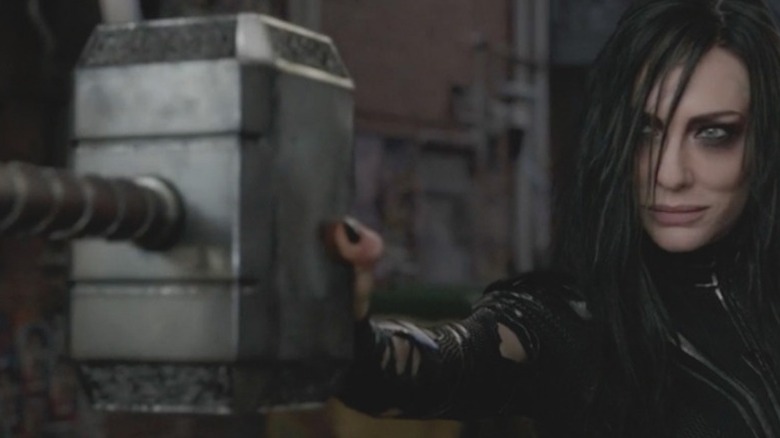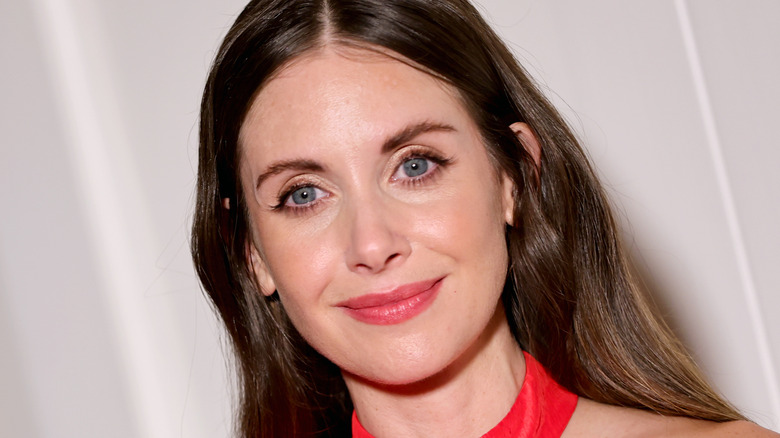Wild Stories From Marvel Films That Are Actually True
We may receive a commission on purchases made from links.
The Marvel Cinematic Universe is the most successful and highest-grossing film franchise in the history of the motion picture industry. Its 29 films (to date) — including 2019's "Avengers: Endgame," which is the second highest-grossing film of all time — have estimated global ticket sales of more than $27.3 billion. That figure, combined with the influence of Marvel's properties on popular culture through live-action television, animation and global merchandising, puts Marvel Studios in a league with more modest-sized countries than production entities (Here's a 2022 GDP list for comparison).
Making a Marvel movie is a bit like marshaling the military forces of a small country: they need a big-name cast, talented filmmakers, and a huge, dedicated crew of technicians tasked with turning comic book stories into not only movie gold but relatable and memorable experiences. By all accounts, this is a challenging process for all involved, and requires a lot of luck, ingenuity, and flashes of inspiration at the absolute last minute.
There are dozens, if not hundreds of stories about the making of the MCU, including a few hard-to-believe but altogether true accounts of scripting changes, behind-the-scenes machinations, and secret casting choices. Following is a spoiler-heavy list of wild stories about Marvel films that also happen to be true.
Odin's death was much darker in Thor: Ragnarok
The death of Anthony Hopkins' Odin in "Thor: Ragnarok" offers a touch of melancholy emotion to Taika Waititi's boisterous action-comedy, as the father of Thor and Loki peacefully accepts that his time has come to an end. However, a deleted scene in the massive Infinity Saga Blu-ray boxset reveals that Odin's passing was initially anything but pastoral. Director Taiki Waititi situated the action in a grimy alley in New York City, where Thor and Loki find Odin living in dire poverty. The visibly confused All-Father babbles about Asgard being unreal and Hela's arrival, before the Goddess of Death herself arrives to brutally stab Odin to death. She caps this unpleasant moment by destroying Mjolnir; if that sounds familiar, chances are you caught a glimpse of this scene in the "Ragnarok" theatrical trailer.
In the book "The Story of Marvel Studios: The Making of the Marvel Cinematic Universe," Waititi stated that Anthony Hopkins spurred the change in his death scene. "Tony has a reaction to the sort of sentimentality of Hollywood and Hollywood films, and rightly so," said Waititi (via Funmauj). "My reaction was like, 'Yeah, Tony, I hate that stuff too, so let's shift away from that. How do we subvert this and make this a more interesting scene?'"
It also appears that fan reaction had something to do with the change. While watching the film on Instagram Live, Waititi said it was necessary to move the scene to Norway in order to establish it as the home of New Asgard. "Also, the test audiences felt bummed out about Odin dying next to trash and garbage in an alley," he explained.
Steve Rogers' to-do list is different around the world
There's a sweetly humorous moment in "Captain America: The Winter Soldier" where the audience sees Steve Rogers' to-do list. The list, written in a small notebook, is a collection of cultural moments that Steve missed during his seven-decade slumber under the Arctic ice. A quick close-up reveals that Steve's list includes the TV series "I Love Lucy," the 1969 Moon landing, and soul great Marvin Gaye's soundtrack to the 1972 film "Trouble Man," as recommended by Sam Wilson/Falcon.
According to a number of sources, Steve's to-do list is different depending on the territory in which you're watching the film. The list (via Business Insider) shares five entries in every international version: Thai food, "Rocky" (and "Rocky II"), "Star Wars" and "Star Trek," and the "Trouble Man" soundtrack.
A Reddit user compiled 10 different shots of the to-do list from various countries, which you can find here. In the U.K. version, Steve wants to check up on the BBC's "Sherlock" (starring future fellow Avenger Benedict Cumberbatch), the Beatles, and OG James Bond Sean Connery. In the South Korean version, Steve's list includes the game "Dance Dance Revolution," Park Chan-Wook's harrowing thriller "Oldboy" (presumably the original 2003 version, not the 2013 U.S. remake with fellow MCU stars Josh Brolin and Elizabeth Olsen), and South Korean football champ Ji-Sung Park, while in the Australian version, he plans to check out such Down Under icons as Steve Irwin and AC/DC.
The original Phase 1 slate excluded four main Avengers
In the mid-2000s, Marvel Entertainment sought to gain greater returns on feature films developed from their stable of comic book heroes and launched their own independent production entity, Marvel Studios. Under the direction of then-CEO David Maisel and president of production Kevin Feige, they decided to develop a slate of feature films that they would distribute through studios like Paramount. Having sold the rights to several of its most iconic franchises — Spider-Man, the X-Men, and the Fantastic Four — they announced a roster of 10 features for release over the next eight years.
That initial line-up, announced in 2005, was anchored by the Avengers, Ant-Man, Captain America, Black Panther, Doctor Strange, Hawkeye, Nick Fury, Shang-Chi, and two lesser-known teams (at least, to general moviegoing audiences): Cloak and Dagger and the pre-teen quartet Power Pack. Notably absent from the roster: Iron Man, Thor, Black Widow, and the Hulk, all of whom were members of the Avengers, and all of whom were properties whose licensing rights were owned by other companies like Sony, Paramount, New Line, and Universal.
The rights for each of these four characters eventually returned to Marvel, which reshuffled the initial 10 properties and placed Iron Man and the Hulk as its first two productions. Shang-Chi would wait nearly two decades before gaining his place in the MCU, while Cloak and Dagger enjoyed a two-season run on Freeform before joining the third and final season of "Runaways" on Hulu. As for the Power Pack, a feature film was in development in 2017, but little has been heard since.
There's a long list of unrealized Marvel movies
Any studio, even one as productive as Marvel, has its list of unrealized projects. Given the sheer number of characters in the Marvel Comics stable, it's understandable that dozens, if not hundreds, of heroes and villains have yet to make the leap from page to screen. That number doesn't even include the many Marvel properties that underwent multiple false starts, including Edgar Wright's convoluted attempts with Ant-Man, James Cameron's treatment for a Spider-Man movie in the 1990s, and Quentin Tarantino's pre-fame pass on Luke Cage (via The Guardian).
Among the Marvel movie projects that never made it past the planning stage was a film about the reanimated cybernetic soldier Deathlok, though the character was featured on "Agents of SHIELD." James Gunn briefly considered (via Facebook) films with Hit Monkey and a Hulk/Red Hulk faceoff before tackling "Guardians of the Galaxy," while "Fargo" creator Noah Hawley was attached to a Doctor Doom origin story that according to him, remains in limbo while the MCU marches towards its take on the Fantastic Four.
That status appears to also apply to other non-MCU projects, such as Drew Goddard's long-gestating Sinister Six film, a team-up with Hasbro Pictures for Rom the Space Knight, and plans to bring Black Cat and Silver Sable to the screen, both as a duo and as solo acts.
The strange saga of Doctor Strange movies
Few Marvel characters have taken so many different paths to a live-action movie as Doctor Strange. Fans know about the Sorcerer Supreme's previous live-action excursions: the 1978 TV movie with Peter van Hooten as Strange, as well as "Doctor Mordrid," which began life as a Strange movie before the studio's licensing option expired. However, several other filmmakers have also attempted to open the Sanctum Sanctorum for movie audiences.
The first pass at a Doctor Strange theatrical feature came in 1986, when "Back to the Future" screenwriter Bob Gale penned a script that covered Strange's transition to master of the mystic arts. Though Gale was well-versed in Marvel lore, the script never progressed beyond the page. "Scream" director Wes Craven didn't have much luck either; tasked with a Doctor Strange pic for Savoy Pictures in 1992, his take vanished after the company collapsed in the middle of the decade.
Meanwhile, "Repo Man" director Alex Cox worked with the character's co-creator, Stan Lee, on a feature adaptation. Their script reads like a classic Marvel adventure with a few odd flourishes (Merlin teams up with Strange). It might have yielded some terrific results if its production entity, Regency Pictures, hadn't been hobbled by distributor Warner Bros. Pictures' conflict with Marvel over merchandising.
Two more promising adaptations surfaced before Scott Derrickson directed "Doctor Strange" for the MCU in 2016. "Blade" and "Dark Knight" writer David Goyer was attached to a Strange feature in the early 2000s. That didn't come to pass, a fate shared with Guillermo del Toro and Neil Gaiman's adaptation, which never progressed beyond the discussion phase.
Trevor Noah has a little-known Marvel cameo
The MCU seems to appreciate celebrity cameos in their films as much as they enjoy capturing viewers' attention with Easter eggs (see below). The best-known of these is Stan Lee, who appeared in eclectic cameos in nearly every Marvel movie adaptation from 2000's "X-Men" to a posthumous turn in "Avengers: Endgame," but actors ranging from Matt Damon and Ken Jeong to Chris O'Dowd and Natalie Dormer have all turned up in Sony-Marvel or MCU cameos. That doesn't include the actors who lent their voices to AI characters, like Kerry Condon (Iron Man armor AI Friday) and Jennifer Connelly (suit AI Karen in "Spider-Man: Homecoming").
However, many MCU viewers weren't aware of another popular performer voicing an MCU AI in "Black Panther." When CIA agent Everett K. Ross pilots a virtual plane in the film's finale, he's guided through its operating system by the voice of the ship's AI system, created by Letitia Wright's Shuri. South African comedian and "Daily Show" host Trevor Noah provides the voice of the system, which is billed as "Griot" — the West African term for "storyteller" — in the film's credits. Noah told E! News that though he was pleased to voice the Wakandan AI system, he would have taken any role in director Ryan Coogler's film. "I [would have been] a tree in Wakanda," he joked. "I would have done that proudly. I want to be Tree No. 5 in Wakanda."
The true reason behind the hammering sound in Endgame's credits
"Avengers: Endgame" closes out the first three phases of the Marvel Cinematic Universe, and as such, does not include the post-credits sequences that viewers have come to expect from the studio's roster. It instead presents a lengthy and affectionate tribute to its sizable cast, as well as a standalone spotlight on each of the main line-up of Avengers. After that, the epic-sized list of technical and production credits unspools, followed by an odd audio cue: the sound of metal being struck with a hammer.
Marvel Studios chief Kevin Feige conceived the idea of capping "Endgame" with a sound that would pay homage to the MCU legacy and bring viewers back to a foundational moment: the sound of Tony Stark constructing the crude Iron Man prototype suit in the first "Iron Man" film. In an interview with Business Insider, "Endgame" co-editor Jeffrey Ford said, "We dug through the elements of 'Iron Man 1' and found the exact piece of sound from the print master. We laid it in against the [Marvel Studios] logo and adjusted the rhythm slightly. We showed Kevin and he gave it his blessing."
Why the first Guardians has two writing credits
Though James Gunn is attributed as the primary architect behind the success of "Guardians of the Galaxy," he shares writing credit on the first film with Nicole Perlman, a New York University grad who began work on the script in 2009 while she was part of Marvel's screenwriting program. According to an interview with Buzzfeed, Perlman chose the team line-up that appeared in their debut feature, reworked Peter Quill's back story and chose Thanos as the film's primary antagonist. She returned for a second draft in 2011 before her contract with the studio expired, after which Gunn was attached to rewrite and direct "Guardians."
In an interview with the Hollywood Reporter, Perlman said that Gunn's script "bumped the humor up and added some characters and deepened the scenes." The added characters included Thanos's daughter, Nebula, and a revision of Yondu as Quill's mentor-turned-pursuer, though the most notable addition in terms of character is that of Ronan the Accuser as the main villain.
According to Gunn, the differences between his draft and the original script go beyond the characters and humor. "The story is different, there's no Walkman, the character arcs are different. It's not about the same stuff," he said in a roundtable discussion for FilmDivider (via Slate). For the record, there appears to be no bad blood between Gunn and Perlman (though some outlets have attempted to craft it), and both have continued a relationship with Marvel. Perlman contributed to the story for "Captain Marvel," while Gunn has completed work on "Guardians of the Galaxy Vol. 3" and the upcoming Christmas special for Disney+.
Some of the MCU's most memorable lines were improv
It's no secret that the MCU is filled with hilarious, memorable bits of dialogue that were in many cases, invented by the actors themselves. Two enduring examples are Robert Downey Jr. dropping "I am Iron Man" as the final line in the first film and Andrew Garfield's Peter Parker #3 telling Tom Holland and Tobey Maguire's versions that he loved them in "No Way Home." However, those aren't the only improvised moments in MCU features.
Though relatively new to the MCU, Florence Pugh quickly proved her talent for improv in both "Black Widow" and "Hawkeye." Her real-life concern over the safety — and showiness — of Natasha's signature landing prompted the scene in which Yelena ribs her sister about the move in "Black Widow." Meanwhile, Pugh and Hailee Steinfeld improvised much of Yelena and Kate Bishop's tense discussion over macaroni and cheese on "Hawkeye."
The MCU's talented cast also improvised some major dramatic moments as well. According to "Doctor Strange" director Scott Derrickson, Benedict Cumberbatch was responsible for the meaningful look between Strange and Tony Stark in "Endgame" and the sorcerer's slowly raised index finger, which underscored the sole possible outcome (out of 14 million possibilities) that would save the Earth from Thanos.
Also improvised: Jonathan Majors' He Who Remains leaping on the table in "Loki"; M'Baku (Winston Duke) hooting to silence Everett Ross (Martin Freemen) in "Black Panther"; and the entire, heartrending exchange between Vision and Wanda in "Avengers: Infinity War," where he attempts to convince her to remove the Mind Stone and destroy him in order to save the universe.
Marvel's Creative Committee reportedly became a problem for the MCU
When Marvel Studios launched in 2005, it worked closely with a development team to help bring its comic book properties to the screen. The Marvel Creative Committee, as it became known, consisted of Marvel Entertainment president Alan Fine and chief creative officer Joe Quesada (a former Marvel editor and artist), as well as writer-artist Brian Michael Bendis and Marvel Comics president of publishing Dan Buckley. The committee provided notes on MCU projects to Marvel Studios chief Kevin Feige, who at the time reported to Marvel Entertainment's then-CEO, Isaac Perlmutter.
Though many filmmakers and executives who worked with the committee have refrained from speaking on record about its involvement in Phases 1 through 3, stories abound about how its notes impeded numerous projects. However, some of those filmmaking entities have spoken out. James Gunn, who wrote and directed "Guardians of the Galaxy," stated in a Facebook Q&A that the committee's notes on the film's villain, Ronan the Accuser, reduced his impact in the final film.
Problems with the committee have also been cited by various sources for the tension between the studio and Joss Whedon during the making of "Avengers: Age of Ultron" and with director Edgar Wright, which led to him abandoning "Ant-Man." Whether a direct link existed between these production problems and the committee or not, a reorganization of Marvel Studios' chain of command took place in 2015, several years after its purchase by Walt Disney Studios. Feige now reports directly to Disney CEO Bob Chapek and Disney Studios chairman Alan Bergman.
The MCU loves inserting Easter eggs for fans
The MCU often rewards its fans by dotting its features with visual and verbal references to its long and complex history. Many of these Easter eggs get a spotlight moment, like the appearance of the original Human Torch suit in "Captain America: The First Avenger" or the parade of Spider-Man villains glimpsed in the multiverse's cracks in "Spider-Man: No Way Home." But others are only visible by eagle-eyed fans who pore over minute details in every frame. These true believers have found a hidden host of relatively obscure Marvel heroes and villains in the architecture and settings of several films.
Chief among these are images of four characters — the extraterrestrial hero Beta Ray Bill, Hulk antagonist the Bi-Beast, and antiheroes Man-Thing and Ares — rendered as colossal statues that pay tribute to their former status as champions on the planet Sakaar in "Thor: Ragnarok." Jack Kirby's space dragon Fin Fang Foom, who debuted in Issue 89 of "Strange Tales," is glimpsed in streamlined form on a billboard in "Iron Man." Elsewhere, "Doctor Strange in the Multiverse of Madness," offered a glimpse of the Living Tribunal (which also appeared on the debut season of "Loki").
Arguably, one of the most obscure Easter eggs turns up in "The Avengers," when Nick Fury gives Steve Rogers the SHIELD file on the Tesseract. The document, which details the possible scope of the object's powers, includes a brief reference to Mephisto, one of Marvel's most powerful antagonists, and the Infinity Gems. It also suggests the possibility of multiple Tesseracts, or Cosmic Cubes, which have turned up in a number of Marvel Comics titles since the mid-1960s.
The Endgame writers doubted the time travel angle
In "Avengers: Endgame," Scott Lang (Ant-Man) sums up what many moviegoers feel about time travel plot devices. When asked by Steve Rogers if he's talking about using a time machine to defeat Thanos, Scott backpedals until admitting that his solution does hinge on that creaky sci-fi trope. "Yeah, I know it's crazy," he adds forlornly.
As co-screenwriter Christopher Markus noted on the Blu-ray commentary for "Endgame" (via Cinemablend), Scott's line echoed their own concerns about adding time travel to the plot. "[It] sort of mirrors us sitting in a room trying to figure out how the hell to get ourselves out of the corner we wrote ourselves in at the end of 'Infinity War' and entertaining the idea of a time machine and then feeling that it's the stupidest idea you could possibly have," he explained.
But as Markus told the New York Times, Ant-Man and his adventures in the Quantum Realm actually helped them embrace time travel. "We all sat there going, really? We're going to do time travel?" he said. "And there really is, in people's theory of the Quantum Realm, a time thing in the MCU, right now, available to us, with a character we haven't used yet."
Why Wanda and Quicksilver aren't mutants in the MCU
As previously mentioned, Marvel Entertainment kept itself afloat during the 1990s by licensing the film rights to its characters to various studios: Spider-Man and the various Spider-Verse characters went to Sony, the Hulk was corralled by Universal, and the X-Men went to Fox. When Marvel Studios announced its initial 10 films for Phase 1 of the Marvel Cinematic Universe, it included the Avengers, which posed a problem for two long-running characters associated with the team: Wanda Maximoff (Scarlet Witch) and her brother, Pietro (Quicksilver).
The siblings began their comic book careers as mutants, who fought the X-Men as part of the Brotherhood of Evil Mutants under Magneto, who acted as their de facto father. But after splitting with Magneto, the Maximoffs were recruited by the Avengers, while Marvel Comics continually retconned their origins.
That disassociation led to an unusual agreement between Marvel and Fox when it came to the two characters. Both studios could use the Scarlet Witch and Quicksilver in their film projects, but Marvel couldn't reference their connection to the X-Men and Fox had to avoid labeling the siblings as Avengers. The arrangement allowed Evan Peters to play a Quicksilver fathered by Magneto in three "X-Men" features for Fox, while Aaron Taylor-Johnson's Quicksilver and his sister — Elizabeth Olsen's Wanda Maximoff — are Hydra recruits in the MCU who gain their powers through experimentation before joining Earth's Mightiest Heroes in "Avengers: Age of Ultron." The arrangement became a thing of the past after Disney acquired Fox in 2017, allowing Evan Peters to play a sort-of Quicksilver on "WandaVision."
Marvel heroes faced different villains in MCU first drafts
The MCU has brought many of Marvel's most memorable villains to the screen. To date, its rogues' gallery includes Thanos, Loki, the Red Skull, Mysterio, the Vulture, the Mandarin (well, sort of), and in "Spider-Man: No Way Home," a fearsome quintet of evildoers (Green Goblin, Doctor Octopus, Electro, the Lizard, and the Sandman) from Sony's Spider-Man Universe. However, many MCU films included entirely different villains in early script drafts and during pre-production.
The most notable of these initial considerations was Hela, who according to Marvel Studios president Kevin Feige, was slated to menace "Thor: The Dark World." There's no clear answer as to why Dark Elf leader Malekith was ultimately tapped to face the God of Thunder in his second standalone feature, but we're glad for the change, given how Cate Blanchett's elegantly evil take on Hela adds so much to the enjoyment of "Thor: Ragnarok."
Other first-draft MCU bad guys include Nightmare, ruler of the Dream Dimension, who was supposed to face off against Doctor Strange in both of his solo adventures. A review of early script drafts for MCU titles also reveals that Ezekiel Stane — the son of Jeff Bridges' Obadiah Stane from "Iron Man" — was on deck to back up Loki during the Battle of New York in "The Avengers."
The monstrous MODOK also had several shots at MCU stardom, including "Captain America: The Winter Soldier," before his starring turn in the eponymous Hulu comedy series and upcoming turn in "Ant-Man and the Wasp: Quantumania." And big-game bad guy Kraven the Hunter was under consideration for "Black Panther" before gaining his own spotlight vehicle as part of the Sony Spider-Verse in 2023.
Many MCU stars weren't the first choice to play their roles
It's hard to conceive of the MCU without the actors who play its heroes and villains. Performers like Robert Downey Jr., Tom Hiddleston, and Samuel L. Jackson are permanently linked in the minds of fans to their Marvel characters. But as with all films, many actors were considered for MCU projects before the final casting choices were made. Some are well known, like Emily Blunt as Black Widow and "Aquaman" star Jason Momoa as Drax. But there are a slew of other actors who were at one time in the running to join the MCU.
"Community" and "GLOW" star Alison Brie was among the leading contenders (via Deadline) to play Sharon Carter, aka Agent 13, a role ultimately claimed by Emily VanCamp. Brie was also a rumored casting choice for Jennifer Walters on "She-Hulk," though she dismissed the rumors to Yahoo! Entertainment, stating, "There's a lot of misinformation going on." Asa Butterfield was a frontrunner to play the MCU version of Spider-Man, while Jason Momoa's "Aquaman" castmate, Yahya Abdul-Mateen II, was in the running to play M'Baku in "Black Panther," but was passed over in favor of Winston Duke (via Variety).
Perhaps the most unusual casting consideration for an MCU film was rock icon David Bowie for "Guardians of the Galaxy Vol. 2." In a 2016 Facebook post, writer-director James Gunn wrote that he had discussed a cameo for Bowie in the sequel with MCU chief Kevin Feige. However, the cameo fell through, because as Gunn noted, "I heard from common friends he wasn't doing well." Bowie died of cancer at the age of 69 that same year.
